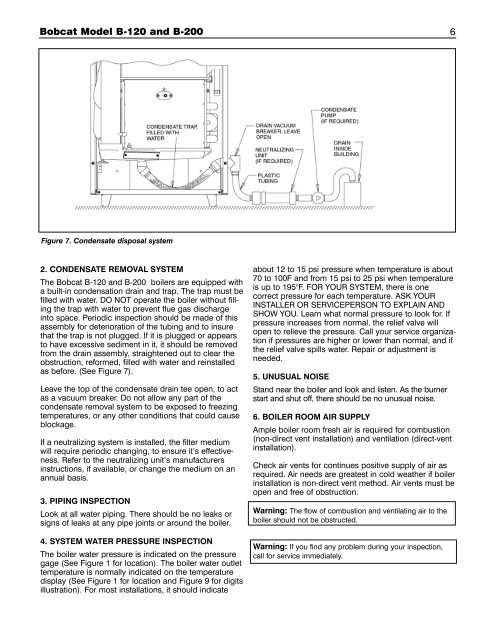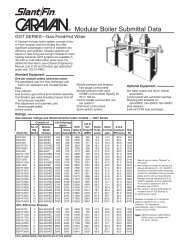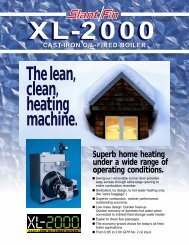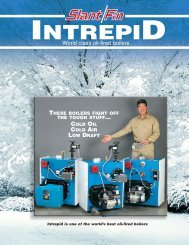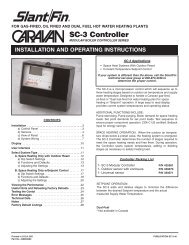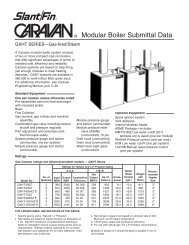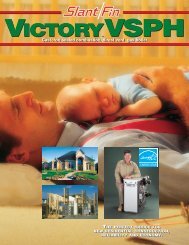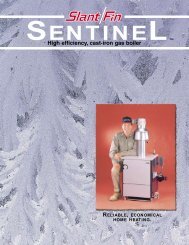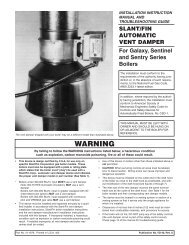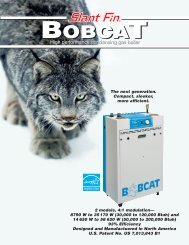Bobcat Boiler Display Board - Slant/Fin
Bobcat Boiler Display Board - Slant/Fin
Bobcat Boiler Display Board - Slant/Fin
You also want an ePaper? Increase the reach of your titles
YUMPU automatically turns print PDFs into web optimized ePapers that Google loves.
<strong>Bobcat</strong> Model B-120 and B-200 6<br />
Figure 7. Condensate disposal system<br />
2. CONDENSATE REMOVAL SYSTEM<br />
The <strong>Bobcat</strong> B-120 and B-200 boilers are equipped with<br />
a built-in condensation drain and trap. The trap must be<br />
filled with water. DO NOT operate the boiler without filling<br />
the trap with water to prevent flue gas discharge<br />
into space. Periodic inspection should be made of this<br />
assembly for deterioration of the tubing and to insure<br />
that the trap is not plugged. If it is plugged or appears<br />
to have excessive sediment in it, it should be removed<br />
from the drain assembly, straightened out to clear the<br />
obstruction, reformed, filled with water and reinstalled<br />
as before. (See Figure 7).<br />
Leave the top of the condensate drain tee open, to act<br />
as a vacuum breaker. Do not allow any part of the<br />
condensate removal system to be exposed to freezing<br />
temperatures, or any other conditions that could cause<br />
blockage.<br />
If a neutralizing system is installed, the filter medium<br />
will require periodic changing, to ensure it’s effectiveness.<br />
Refer to the neutralizing unit’s manufacturers<br />
instructions, if available, or change the medium on an<br />
annual basis.<br />
3. PIPING INSPECTION<br />
Look at all water piping. There should be no leaks or<br />
signs of leaks at any pipe joints or around the boiler.<br />
4. SYSTEM WATER PRESSURE INSPECTION<br />
The boiler water pressure is indicated on the pressure<br />
gage (See Figure 1 for location). The boiler water outlet<br />
temperature is normally indicated on the temperature<br />
display (See Figure 1 for location and Figure 9 for digits<br />
illustration). For most installations, it should indicate<br />
about 12 to 15 psi pressure when temperature is about<br />
70 to 100F and from 15 psi to 25 psi when temperature<br />
is up to 195°F. FOR YOUR SYSTEM, there is one<br />
correct pressure for each temperature. ASK YOUR<br />
INSTALLER OR SERVICEPERSON TO EXPLAIN AND<br />
SHOW YOU. Learn what normal pressure to look for. If<br />
pressure increases from normal, the relief valve will<br />
open to relieve the pressure. Call your service organization<br />
if pressures are higher or lower than normal, and if<br />
the relief valve spills water. Repair or adjustment is<br />
needed.<br />
5. UNUSUAL NOISE<br />
Stand near the boiler and look and listen. As the burner<br />
start and shut off, there should be no unusual noise.<br />
6. BOILER ROOM AIR SUPPLY<br />
Ample boiler room fresh air is required for combustion<br />
(non-direct vent installation) and ventilation (direct-vent<br />
installation).<br />
Check air vents for continues positive supply of air as<br />
required. Air needs are greatest in cold weather if boiler<br />
installation is non-direct vent method. Air vents must be<br />
open and free of obstruction.<br />
Warning: The flow of combustion and ventilating air to the<br />
boiler should not be obstructed.<br />
Warning: If you find any problem during your inspection,<br />
call for service immediately.


